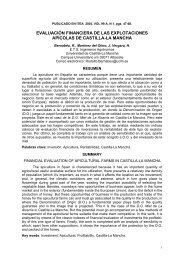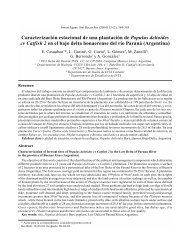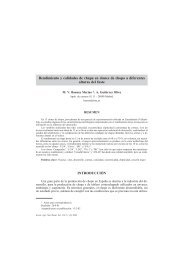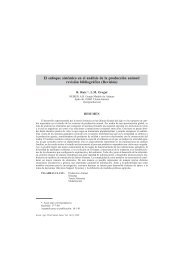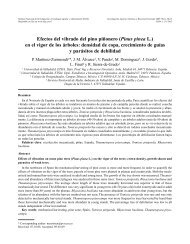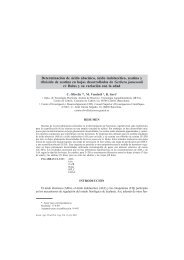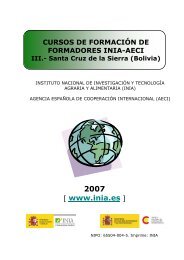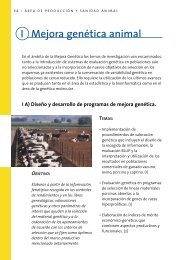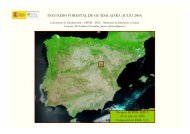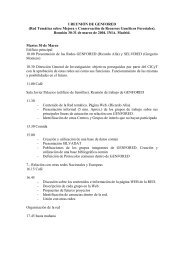Status of medicinal and aromatic plants in - Inia
Status of medicinal and aromatic plants in - Inia
Status of medicinal and aromatic plants in - Inia
You also want an ePaper? Increase the reach of your titles
YUMPU automatically turns print PDFs into web optimized ePapers that Google loves.
PRESENTED PAPERS 115<br />
the classification <strong>of</strong> endangered <strong>plants</strong> accord<strong>in</strong>g to the degree <strong>of</strong> danger. Amongst<br />
approximately 3200 plant species (400 <strong>of</strong> them MAPs) known to be <strong>in</strong>digenous or well<br />
adapted to the Slovenian climate, some 10% are considered to be endangered (34 have been<br />
harmed, 77 are vulnerable, 192 are rare). Slovenia has shown much concern <strong>in</strong> the<br />
preservation <strong>of</strong> natural resources such as <strong>medic<strong>in</strong>al</strong> <strong>plants</strong>.<br />
In Slovenia, directives for the national programme <strong>of</strong> production, process<strong>in</strong>g <strong>and</strong> quality<br />
control <strong>of</strong> MAPs have been developed. The strategy for the conservation <strong>of</strong> natural<br />
resources is perceived as <strong>of</strong> the utmost importance. The first stage <strong>of</strong> the programme<br />
consists <strong>in</strong> the monitor<strong>in</strong>g <strong>and</strong> characterization <strong>of</strong> natural populations <strong>and</strong> <strong>in</strong> situ<br />
conservation <strong>of</strong> evaluated <strong>in</strong>digenous plant material. Data from different sources (e.g.<br />
Ljubljana Herbarium) <strong>and</strong> plant <strong>in</strong>ventories are used to obta<strong>in</strong> data on wild MAP accessions<br />
<strong>in</strong> Slovenia.<br />
Conservation <strong>of</strong> the natural heritage for future generations, followed by the importance <strong>of</strong><br />
attractive l<strong>and</strong>scapes, are among the pr<strong>in</strong>cipal aspects <strong>of</strong> the conservation strategy <strong>in</strong> the<br />
field <strong>of</strong> MAPs. This can be achieved by:<br />
- collect<strong>in</strong>g <strong>and</strong> estimation <strong>of</strong> the danger level;<br />
- active conservation (conservation <strong>in</strong> situ);<br />
- sensible/susta<strong>in</strong>able use <strong>of</strong> wild <strong>plants</strong> (for ex situ conservation);<br />
- limitation <strong>of</strong> massive exploitation <strong>of</strong> wild <strong>plants</strong> by successive <strong>in</strong>troduction <strong>in</strong>to<br />
cultivation <strong>of</strong> known genotypes <strong>in</strong> suitable environments.<br />
In Slovenia, <strong>in</strong> situ <strong>in</strong>ventory<strong>in</strong>g/monitor<strong>in</strong>g <strong>and</strong> estimation <strong>of</strong> population density as well<br />
as quality control with the objective <strong>of</strong> def<strong>in</strong><strong>in</strong>g particular/optimal market use <strong>of</strong> raw<br />
materials are planned to be carried out through the multi-user relational database<br />
MEDPLANT. Wild populations will be <strong>in</strong>cluded <strong>in</strong> the national collection <strong>of</strong> <strong>medic<strong>in</strong>al</strong> <strong>and</strong><br />
<strong>aromatic</strong> <strong>plants</strong>. Further activities related to future cultivation (such as propagation <strong>of</strong> plant<br />
materials <strong>and</strong> seed breed<strong>in</strong>g) are planned.<br />
On-farm conservation<br />
Pr<strong>in</strong>ciples <strong>and</strong> techniques <strong>of</strong> on-farm conservation <strong>of</strong> local ecotypes <strong>and</strong> l<strong>and</strong>races <strong>of</strong><br />
cultivated <strong>plants</strong> <strong>and</strong> traditional cultivation techniques have been widely <strong>in</strong>troduced <strong>in</strong> less<br />
developed parts <strong>of</strong> the world. In the last few years a need for similar actions was identified<br />
for Europe, where a high degree <strong>of</strong> genepool erosion was found <strong>in</strong> field crops.<br />
In Slovenia, there is no special <strong>in</strong>stitution engaged <strong>in</strong> the programme <strong>of</strong> on-farm<br />
conservation, breed<strong>in</strong>g or management. Some <strong>of</strong> the <strong>in</strong>stitutions that ma<strong>in</strong>ta<strong>in</strong> genetic<br />
resources <strong>of</strong> different crops have contacts with <strong>in</strong>dividual farmers, who ma<strong>in</strong>ta<strong>in</strong> old<br />
varieties on farm. Some NGOs do <strong>in</strong>clude activities similar to on-farm conservation but<br />
there is little coord<strong>in</strong>ation between different parties. There is almost no cooperation between<br />
farmers <strong>and</strong> genebanks <strong>in</strong> the field <strong>of</strong> breed<strong>in</strong>g or genetic improvement <strong>of</strong> local ecotypes.<br />
Regard<strong>in</strong>g MAP on-farm conservation, some valuable species are found <strong>in</strong> Slovenia. The<br />
most <strong>in</strong>terest<strong>in</strong>g crop that is considered as a traditional oil <strong>and</strong> <strong>medic<strong>in</strong>al</strong> plant is Camel<strong>in</strong>a<br />
sativa (L.) Crantz, still widespread <strong>in</strong> the Koroška region. It is predom<strong>in</strong>antly used as a raw<br />
material <strong>in</strong> oil process<strong>in</strong>g. Some <strong>in</strong>complete data on its cultivation were collected by the<br />
extension service <strong>of</strong>fices <strong>in</strong> Dravograd <strong>and</strong> Slovenj Gradec <strong>and</strong> need further survey. Now<br />
almost 20 seed samples are under <strong>in</strong>vestigation at the Agricultural Faculty <strong>of</strong> the University<br />
<strong>of</strong> Maribor <strong>and</strong> partly <strong>in</strong> the fields <strong>of</strong> the Institute for Hop Research <strong>and</strong> Brew<strong>in</strong>g <strong>in</strong> Žalec,<br />
where some data on cultivation technology <strong>and</strong> oil process<strong>in</strong>g mach<strong>in</strong>ery have been<br />
collected.<br />
The second <strong>in</strong>terest<strong>in</strong>g potential <strong>medic<strong>in</strong>al</strong> crop is buckwheat, Fagopyrum esculentum<br />
Moench. Buckwheat was very popular <strong>in</strong> the old days <strong>and</strong> some knowledge about<br />
technology <strong>and</strong> l<strong>and</strong>races is still available. But s<strong>in</strong>ce very good cultivars were developed <strong>in</strong>




